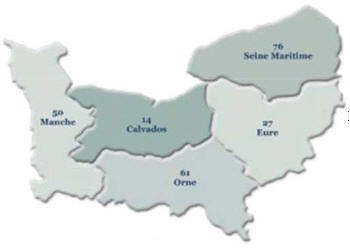Normandy is made up of five rich and varied counties which offer each visitor something unique.

Normandy Departments
Each has its own characteristics and is identified by a number which figures both in the post code addresses and on car number plates.
- Calvados 14
- Eure 27
- Manche 50
- Orne 51
- Seine Maritime 76
Calvados (14)

St Pierre Cathedral in Lisieux
Bears the name of its most famous spirit. The county covers much of the coastline of the D Day Landing Beaches and historic towns such as Caen, Bayeux, Honfleur and resorts of Deauville and Trouville.
The lands around the pilgrimage town of Lisieux form the famous Auge Valley. From William the Conqueror, to the Battle of Normandy to medieval festivals, Calvados offers a wealth of heritage you simply can’t leave behind.
The River Eure (27)
Gives its name to the county which lies south of the Seine and between the Auge Valley and the western outskirts of Paris. Crossed by many other river valleys, the landscapes of the Eure county are probably the most typical of Normandy with sleepy villages and timber fronted and thatched cottages abound. Evreux is the county town, nearby Monet’s gardens in Giverny and like Château Gaillard or Château du Champ de Bataille, among many others.
Manche (50)

Coast of Normandy where WW2 D-Day landing took place
Forms the western coastline of Normandy. From the Landing Beach of Utah Beach, via the Cherbourg Peninsula to the Bay of Mont St Michel, the sea has had a major influence on this part of the region. Mont St Michel is a medieval treasure known the world over, but the Manche county is also home to several other historical and natural attractions such as Villedieu les Poêles, Hambye Abbey and the Cotentin Bessin Wetlands Park.
Orne (61)
Lies in the south of the region and is Normandy in its most natural state. Green fields, deep river valleys and forests abound, punctuated by fine manor houses and estates. Some of these are home to well known stud farms for this is also the land of the horse. The county town of Alençon is famous for traditional lace making while Bagnole de l’Orne’s thermal station offers health, wellness and relaxation in a wonderful natural setting.
Seine Maritime (76)
Fills the area between the Seine Valley and the Channel Coast. Dramatic cliff lines, rolling open countryside and the twists and turns of the River Seine are the main geographic features while the town of Rouen is the jewel in the crown. Most landscapes are immortalised by the famous impressionist artists : Etretat, Fecamp, Dieppe, Rouen Cathedral or Le Havre are such places of inspiration. Normandy Quality Tourisme
Normandy’s regional Authorities
Ensure the visitor experience is of the highest standards viaThe logo of quality charter of Normandy Quality Tourisme the quality charter “Normandy Quality Tourisme”. You will notice the logo in hotels, restaurants and visitor attractions around the region and in the following pages. For full details of establishments in Normandy which have achieved the Quality Charter visit: www.normandie-qualite-tourisme.com
Disabled Friendly

credits : Tourist Board
Leave a Reply